GALLERY
Welcome to the gallery section. In this section, we have
posted some nice photos. These are some of the nicest photos that we had
taken through the years.
I have started taking photos back in 1993. The first heavenly
object was the moon. Why moon? Well, it is one of the easiest object around
that you can capture on negatives. It's bright, big and can be seen almost
everyday, although at different time, of course.
Most of these photos were quite out-dated. I have yet
have time to upload new, improved quality photos. The photos were taken
using minimum astrophotos equipment, ie, just a simply tripod, cable release
and a camera, of course. I have just acquire a german equatorial mount
and will use the mount to take photos with longer exposure duration.
So, do come back regularly.
We have just returned from annular
eclipse observation at Tanjung Sekakap, Mersing, Johor. Here's the full
report
Close conjuction between Venus/Jupiter/Moon
These images were taken in the morning of 23rd April
1998. On that day, Jupiter and Venus lies about 1/3 of a degree apart.
The Moon also located on the same part of the sky. The three object can
be seen in a field of view of a 7x50mm binocular.

This is a CCD image of the event. The brighter and higher
planet is Venus while Jupiter can be seen on the lower right. The
image at the bottom left, is the false image of the Moon created by the
camera lens and the image on the bottom right is actually a small part
of a cloud that drifts by at the time the image was taken.

The image of Jupiter taken on the same day.
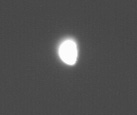
Venus
Click to see the photos of the following objects:-
 The
Sun
The
Sun The
Moon
The
Moon  The
Planets
The
Planets  The
Stars
The
Stars  The
Comet
The
Comet
THE
SUN




These images were taken during the total solar eclipse
of 1995. Since I don't owned any telescope during that time, I used a 500mm
Russian telephoto lens fitted with a mylar solar filter. This cause the
first two images to be blue in colour. This filter
cuts all the IR and UV light from entering the telescope while letting
through 0.001% of the visible light.
At times, the sun disk may appeared
featureless. But there are times when the sun surface is filled with dark
spot distributed randomly across the disk. These are sunspots, an area
appeared dark in colour, and have a lower temperature than it's surrounding.
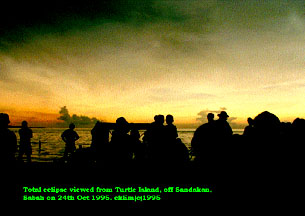
This is how it looks like in the middle of a total solar
eclipse. I took this shot using my Nikon FM10 and 35mm lens.
**********************************
THE
PLANETS
The planets are very difficult to photograph. You'll need
to have a resonable size telescope mounted on an equatorial mount for trackking.
High magnification is almost a must for photographing planets.
Photography at high magnification is never easy. You'll
to have a very stable mount to avoid unnecessary vibrations. The target
is also dim, thus the need for long exposure of at least 1sec to 10sec.
This is the reason why I only try planetary photography
recently. I have just gotten myself an equatorial mount and some photography
accessories to enable me to take the photographs of the planets.
**************************************
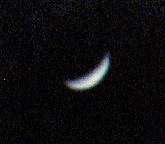
This is not the moon, it's Venus.
VENUS is the second planet from the Sun. It is also the
nearest to the Earth. As it orbits around the Sun, it's apparent diameter
changes drastically. It also stay closed to the Sun most of the time.
The above photo were taken years back using my 7inch homemade
telescope. It was taken early in the morning (about 6am) when the angular
diameter of the planet at the time about 50 arc sec.
Apart from it's constant changes in its phases, no other
details are visible.
****************************************
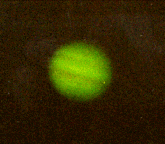
This is the giant gas planet, Jupiter.
JUPITER, is the biggest planet in our solar system. It's
diameter is 11 times bigger than the Earth!. Observing the planet, even
at low magnification, reveals two dark bands, or oftenly call the belts
of Jupiter.
Apart from the belts, you might notice up to four stars,
near to the planet. These stars seems to align in the straight line. These
"stars" are actually the moons of the planet. If you have the chance to
observe the planets in a span of several hours, the moons will move from
it's previous position.
The photo was taken using 4.5inch telescope with 3sec
exposure.
*******************************************

SATURN
The most fasinating planet in our solar system. The ring
could be seen even at low magnification in a small telescope.
This photo was taken using 4.5inch telescope with 5sec
exposure.
THE STARS


THE MILKY WAY......this photo was taken during the major
blackout in 1996. This photo shows the direction to the center of our galaxy,
the Milky Way. You can see the Milky Way under a dark sky. It appears as
a band of light that stretched across the sky. The band of light actually
contains billions of stars, too tiny and close, preventing our eyes from
resolving them.
The photo above was taken with high speed film of 3200ASA
which I bought from US for US$10. The exposure was 30sec with 50mm lens
with F1.4 setting.
Can you identify some object that can be seen in the photo?
Maybe the photo on the right can help you.
The photo has been converted to negative, that mean black
becomes white and white becomes black.
The object with labelled starting with "M" is called the
Messier Object. There are 110 such objects across the sky.
M6-butterfly clusters (because the arrangement of the
stars is like butterfly)
M7-open star cluster
M8-Trifid Nebula
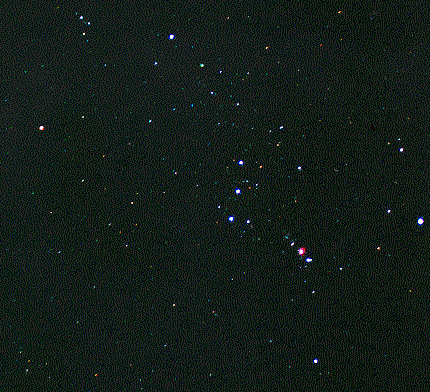
ORION
The Orion constellation is one of the most famous among
88 others. Most people recognize it by the three stars in a straight line.
However, the finest object in this constellation is M42
or also known as Orion Nebula. You can see it on the right of the three
stars. It appears as red patch of light. Astronomer believed that this
is a region where stars are born.
This photo was taken two or three years ago at a camp
site, off Teluk Bahang, Penang. The exposure was 16sec with 400ASA film
at F1.4 setting.
*I have since taken better picture
of the Orion. I will upload it when I have the time.

ETA CARINA
This starfield was located in the south. The photo was
taken after I took some photos of Comet Hale-Bopp back in April 1997.
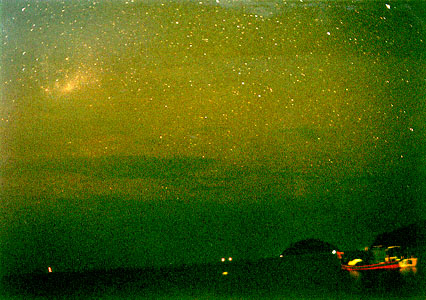
LARGE MAGELANIC CLOUD (LMC)
This object can be seen to the upper left hand side of
the photo. I took this in December 1997 from Gertak Sanggul, Penang. I
have used a 50mm lens, 800ASA film and exposure of about 2 mins.
THE COMET
These are the nomads of our Solar
System. Travelling in highly elliptical orbits, these frozen chunks of
dirty ice arrive from beyond the orbit of Neptune, swing close by the Sun,
and then return to the farthest reaches of the Solar System from where
they came. As a comet swings by the Sun, solar energy sublimates frozen
gases and dust on its surface to created the comet'scoma, or head. Radiation
pressure from the Sun and the solar wind combine to press against the coma's
gas and dust, thus creating the comet's long tail.
Each year, a dozen or more comets
either are discovered or reappear on schedule. Most are quite faint, but
several may eventually become bright enough to be seen in amateur telescope
and binoculars.
Brighter comets may also display
ghostly tails extending behind the coma and opposite the Sun. The brightest
comets have dual tails (one called the ion tail, the other called the dust
tail).
Many may remembered seeing Comet
West back in 1976. But recently, in 1996 Comet Hyakutake and in 1997, Comet
Hale-Bopp put a grand display in our sky.
Here are a couple of comet photos
which I have taken.

COMET HYAKUTAKE
This comet was best seen in March 1996. I was in United
States on work assignment when I took this photo. It is the brightest and
the first comet I have seen visually. The tail can be seen about 25 or
30 degress from the coma. That's about 1/6 of the entire sky!. Some observers
reported seeing the tail stretched over 50 degrees.
Since I was in US, I had to use my Nikon to photograph
it. The widest F ratio my camera lense can achieve is about 3.5 which is
quite bad for this kind of photography.
The film used is 1000ASA rating and exposure of 30sec.
***********************************************

COMET HALE-BOPP
This comet got the honour as the brightest comet of the
century. I have taken this photo on 10th April 1997 from Balik Pulau, Penang.

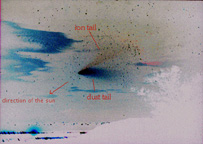
These two photos are the same one. The top one is the
positive, while for the bottom one, I have converts it to negative to show
you the tails.
I have these photos and few others posted in the following
homepage. It contains the largest photo archives on Comet Hale-Bopp.
http://galileo.ivv.nasa.gov/comet/lim3.html
http://galileo.ivv.nasa.gov/comet/lim6.html

This page hosted by  Get your own Free Home Page
Get your own Free Home Page












